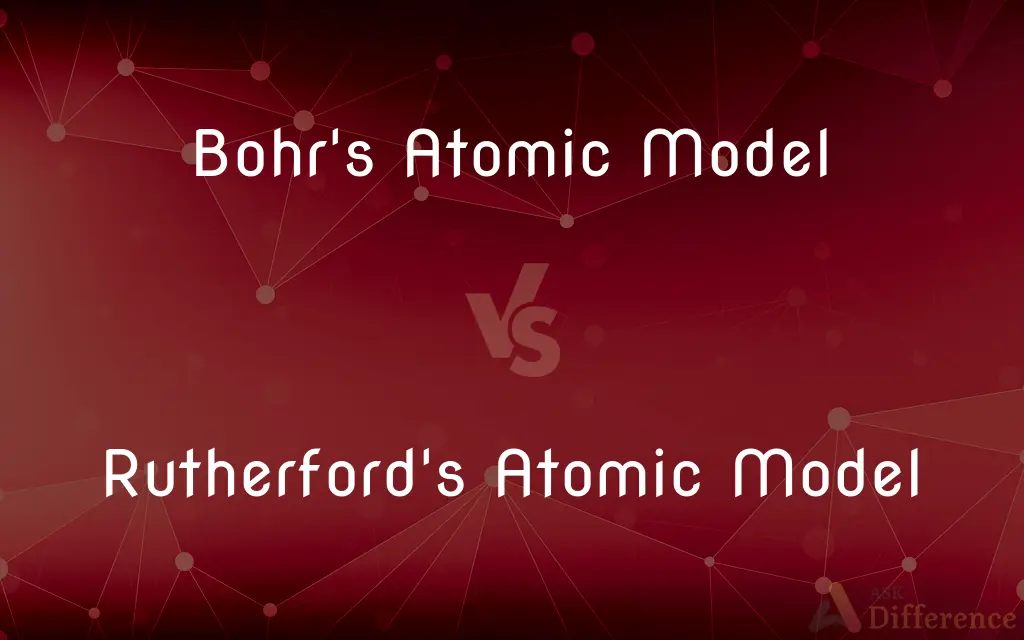Bohr's Atomic Model vs. Rutherford's Atomic Model — What's the Difference?
Edited by Tayyaba Rehman — By Fiza Rafique — Published on January 4, 2024
Bohr’s model depicts electrons in fixed orbits, while Rutherford's describes a nuclear atom with electrons around a dense nucleus.

Difference Between Bohr's Atomic Model and Rutherford's Atomic Model
Table of Contents
ADVERTISEMENT
Key Differences
Bohr's Atomic Model was proposed by Niels Bohr in 1913. This model introduced the concept of fixed energy levels or orbits in which electrons can travel without emitting radiation. According to Bohr, electrons move in these specific orbits around the nucleus, and the energy of an electron is quantized, meaning electrons can only gain or lose energy by jumping from one allowed orbit to another.
Rutherford's Atomic Model, proposed by Ernest Rutherford in 1911, presents the atom as mostly empty space, with electrons orbiting a centrally located nucleus. This model came about from the gold foil experiment, which showed that a small, dense nucleus was positively charged and that electrons were located around the nucleus, but it didn't explain how these electrons were arranged or how they moved.
Bohr's model built upon Rutherford's model by adding quantized orbits. While Rutherford's model suggested that electrons have some distribution around the nucleus, it did not offer a detailed explanation of electron behavior. Bohr's model gave the first insight into the quantized nature of electron energy levels, although it mainly applied accurately to hydrogen-like atoms.
Rutherford's Atomic Model failed to explain the stability of the atom since classical mechanics predicts that electrons in motion around a nucleus should release electromagnetic radiation, lose energy, and spiral into the nucleus. Bohr’s model addressed this issue by postulating that electrons could only occupy certain orbits where they did not release radiation.
While Bohr's Atomic Model was a significant improvement in the atomic theory at the time, it was still an oversimplification. The model worked well for explaining the spectral lines of hydrogen but fell short for more complex atoms. Rutherford's model was foundational but lacked the detail to explain atomic spectra or chemical behavior.
ADVERTISEMENT
Comparison Chart
Electron Orbits
Electrons in fixed, quantized orbits.
Electrons orbiting but not in fixed orbits.
Energy Levels
Defined energy levels for electron paths.
No defined energy levels for electrons.
Atomic Stability
Explains atomic stability via quantum theory.
Could not explain atomic stability.
Spectral Lines
Accounts for hydrogen's spectral lines.
Does not explain spectral lines.
Applicability
Accurate mainly for hydrogen.
More of a general concept, less specific.
Compare with Definitions
Bohr's Atomic Model
It successfully describes the hydrogen atom's emission spectrum.
Bohr's Atomic Model was confirmed by the precise lines in the hydrogen spectrum.
Rutherford's Atomic Model
This model depicts electrons orbiting a central nucleus without defined orbits.
In Rutherford's Atomic Model, the exact paths of electrons remained unknown.
Bohr's Atomic Model
This model introduces quantized energy levels for electrons.
The quantized orbits in Bohr's Atomic Model help explain why atoms emit specific colors of light.
Rutherford's Atomic Model
Rutherford's Atomic Model describes the atom with a dense nucleus and electrons around it.
Rutherford's Atomic Model was derived from the unexpected results of the gold foil experiment.
Bohr's Atomic Model
Bohr's Atomic Model features electrons in stable orbits without radiation emission.
Bohr's Atomic Model revolutionized our understanding of the electron’s motion.
Rutherford's Atomic Model
It lacks an explanation for atomic stability and electron arrangement.
Rutherford's Atomic Model couldn't explain why atoms don't collapse.
Bohr's Atomic Model
Bohr's Model is a foundational concept in quantum mechanics and atomic theory.
Quantum mechanics grew from ideas like those in Bohr's Atomic Model.
Rutherford's Atomic Model
Rutherford's Model is a step beyond the plum pudding model towards modern atomic understanding.
Rutherford's Atomic Model set the stage for the more detailed models that followed.
Bohr's Atomic Model
It is a quantum physics-based model explaining atomic structure and electron behavior.
Chemistry textbooks often illustrate the atom using Bohr's Atomic Model.
Rutherford's Atomic Model
It introduced the nuclear model of the atom.
The discovery of the atomic nucleus was a direct result of Rutherford's Atomic Model.
Common Curiosities
What is Rutherford's Atomic Model?
It's a model describing the atom with a dense nucleus and electrons orbiting around it.
Why was Bohr's Model important?
It introduced the concept of quantized energy levels in atoms.
Was Rutherford's Atomic Model accurate?
It correctly identified the nucleus but couldn't explain electron arrangement.
Did Rutherford's Model include neutron?
No, neutrons were discovered later.
What is Bohr's Atomic Model?
It's a model of the atom with electrons in fixed orbits around the nucleus.
How did Bohr's Model differ from Rutherford's?
Bohr's included quantized orbits for electrons; Rutherford's did not.
What did Rutherford's Model say about the electron?
It suggested electrons orbit the nucleus but gave no details on their arrangement.
Is Bohr's Atomic Model still used today?
It's used as a teaching tool but has been superseded by more advanced quantum models.
Can Bohr's Model explain all atoms?
No, it's most accurate for hydrogen and simplistic for complex atoms.
What experiment led to Rutherford's Model?
The gold foil experiment which showed a small, dense nucleus.
What limitation does Rutherford's Atomic Model have?
It could not explain why negatively charged electrons don't fall into the positively charged nucleus.
How did Bohr's Model explain spectral lines?
By electrons jumping between fixed orbits, emitting specific wavelengths of light.
Did Bohr's Atomic Model use quantum mechanics?
Yes, it incorporated early quantum theory.
How have Bohr's and Rutherford's models influenced modern science?
They were crucial steps in developing the quantum mechanical model of the atom.
Why don't electrons crash into the nucleus in Bohr's Model?
Because they occupy fixed energy levels without radiating energy.
Share Your Discovery

Previous Comparison
Warm Mist Humidifiers vs. Cool Mist Humidifiers
Next Comparison
Ubuntu vs. Windows 10Author Spotlight
Written by
Fiza RafiqueFiza Rafique is a skilled content writer at AskDifference.com, where she meticulously refines and enhances written pieces. Drawing from her vast editorial expertise, Fiza ensures clarity, accuracy, and precision in every article. Passionate about language, she continually seeks to elevate the quality of content for readers worldwide.
Edited by
Tayyaba RehmanTayyaba Rehman is a distinguished writer, currently serving as a primary contributor to askdifference.com. As a researcher in semantics and etymology, Tayyaba's passion for the complexity of languages and their distinctions has found a perfect home on the platform. Tayyaba delves into the intricacies of language, distinguishing between commonly confused words and phrases, thereby providing clarity for readers worldwide.
















































